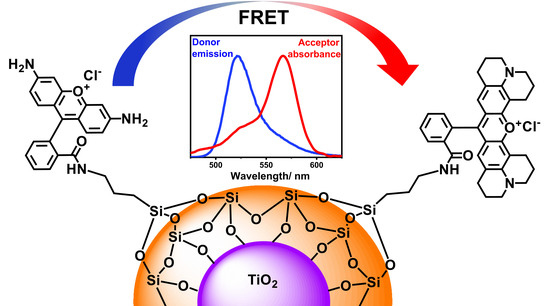New Core-Shell Nanostructures for FRET Studies: Synthesis, Characterization, and Quantitative Analysis
Abstract
:1. Introduction
2. Results and Discussion
2.1. Synthesis and Analysis of TiO2@SiO2-(CH2)3-NH-D/A Nanocomposite
2.2. Spectroscopic Properties
3. Materials and Methods
3.1. Materials and Reagents
3.2. Synthesis
3.2.1. TiO2@SiO2
3.2.2. TiO2@SiO2-(CH2)3-NH2
3.2.3. TiO2@SiO2-(CH2)3-NH-D/A
3.3. Methods
3.3.1. Characteristics of Nanostructures
3.3.2. Theoretical Model and Monte Carlo Simulations
4. Conclusions
Author Contributions
Funding
Institutional Review Board Statement
Informed Consent Statement
Data Availability Statement
Conflicts of Interest
References
- Kalambate, P.K.; Dhanjai; Huang, Z.; Li, Y.; Shen, Y.; Xie, M.; Huang, Y.; Srivastava, A.K. Core@shell Nanomaterials Based Sensing Devices: A Review. TrAC Trends Anal. Chem. 2019, 115, 147–161. [Google Scholar] [CrossRef]
- Xing, Q.; Buono, P.; Ruch, D.; Dubois, P.; Wu, L.; Wang, W.-J. Biodegradable UV-Blocking Films through Core–Shell Lignin–Melanin Nanoparticles in Poly(Butylene Adipate-Co-Terephthalate). ACS Sustain. Chem. Eng. 2019, 7, 4147–4157. [Google Scholar] [CrossRef]
- Chiang, Y.-D.; Dutta, S.; Chen, C.-T.; Huang, Y.-T.; Lin, K.-S.; Wu, J.C.S.; Suzuki, N.; Yamauchi, Y.; Wu, K.C.-W. Functionalized Fe3O4@Silica Core–Shell Nanoparticles as Microalgae Harvester and Catalyst for Biodiesel Production. ChemSusChem 2015, 8, 789–794. [Google Scholar] [CrossRef]
- Chatterjee, K.; Sarkar, S.; Jagajjanani Rao, K.; Paria, S. Core/Shell Nanoparticles in Biomedical Applications. Adv Colloid Interface Sci. 2014, 209, 8–39. [Google Scholar] [CrossRef] [PubMed]
- Singh, R.; Bhateria, R. Core-Shell Nanostructures: A Simplest Two-Component System with Enhanced Properties and Multiple Applications. Environ. Geochem. Health 2021, 43, 2459–2482. [Google Scholar] [CrossRef] [PubMed]
- Tamburro, D.; Fredolini, C.; Espina, V.; Douglas, T.A.; Ranganathan, A.; Ilag, L.; Zhou, W.; Russo, P.; Espina, B.H.; Muto, G.; et al. Multifunctional Core-Shell Nanoparticles: Discovery of Previously Invisible Biomarkers. J. Am. Chem. Soc. 2011, 133, 19178–19188. [Google Scholar] [CrossRef]
- Pellegrino, C.; Volpe, A.; Juris, R.; Menna, M.; Calabrese, V.; Sola, F.; Barattini, C.; Ventola, A. Multiple Dye Doped Core-Shell Silica Nanoparticles: Outstanding Stability and Signal Intensity Exploiting FRET Phenomenon for Biomedical Applications. J. Nanomater Mol. Nanotechnol. 2018, s6, 2. [Google Scholar] [CrossRef]
- Zhu, J.; Maza, W.; Morris, A. Light-Harvesting and Energy Transfer in Ruthenium(II)-Polypyridyl Doped Zirconium(IV) Metal-Organic Frameworks: A Look toward Solar Cell Applications. J. Photochem. Photobiol. A Chem. 2017, 344. [Google Scholar] [CrossRef]
- Lin, Y.-W.; Liu, C.-W.; Chang, H.-T. Synthesis and Properties of Water-Soluble Core-Shell-Shell Silica-CdSe/CdS-Silica Nanoparticles. J. Nanosci. Nanotechnol. 2006, 6, 1092–1100. [Google Scholar] [CrossRef]
- Adamska, E.; Niska, K.; Wcisło, A.; Grobelna, B. Characterization and Cytotoxicity Comparison of Silver- and Silica-Based Nanostructures. Materials 2021, 14, 4987. [Google Scholar] [CrossRef]
- Bojarski, P.; Kulak, L.; Walczewska-Szewc, K.; Synak, A.; Marzullo, V.M.; Luini, A.; D’Auria, S. Long-Distance FRET Analysis: A Monte Carlo Simulation Study. J. Phys. Chem. B 2011, 115, 10120–10125. [Google Scholar] [CrossRef]
- Maliwal, B.P.; Raut, S.; Fudala, R.; D’Auria, S.; Marzullo, V.M.; Luini, A.; Gryczynski, I.; Gryczynski, Z. Extending Förster Resonance Energy Transfer Measurements beyond 100 Å Using Common Organic Fluorophores: Enhanced Transfer in the Presence of Multiple Acceptors. J. Biomed. Opt. 2012, 17, 011006. [Google Scholar] [CrossRef]
- Förster, T. Zwischenmolekulare Energiewanderung und Fluoreszenz. Ann. Phys. 1948, 437, 55–75. [Google Scholar] [CrossRef]
- Stryer, L.; Haugland, R.P. Energy Transfer: A Spectroscopic Ruler. Biol. Pharm. Bull. 1967, 58, 719–726. [Google Scholar] [CrossRef] [PubMed] [Green Version]
- Sahoo, H. Förster Resonance Energy Transfer—A Spectroscopic Nanoruler: Principle and Applications. J. Photochem. Photobiol. C Photochem. Rev. 2011, 12, 20–30. [Google Scholar] [CrossRef]
- Qu, S.; Liu, C.; Liu, Q.; Wu, W.; Du, B.; Wang, J. Solvent Effect on FRET Spectroscopic Ruler. J. Chem. Phys. 2018, 148, 123331. [Google Scholar] [CrossRef] [PubMed]
- Synak, A.; Fudala, R.; Gryczynski, I.; Kułak, L.; Shah, S.; Serdiuk, I.E.; Grobelna, B.; Arłukowicz, P.; Kubicki, A.; Bojarski, P. AMCA to TAMRA long range resonance energy transfer on a flexible peptide. Dye. Pigment. 2018, 158, 60–64. [Google Scholar] [CrossRef]
- Even, U.; Rademann, K.; Jortner, J.; Manor, N.; Reisfeld, R. Electronic Energy Transfer on Fractals. Phys. Rev. Lett. 1984, 52, 2164–2167. [Google Scholar] [CrossRef]
- Belušáková, S.; Martínez-Martínez, V.; Arbeloa, I.L.; Bujdák, J. Resonance Energy Transfer between Dye Molecules in Colloids of a Layered Silicate. The Effect of Dye Surface Concentration. J. Phys. Chem. C 2017, 121, 8300–8309. [Google Scholar] [CrossRef]
- Liu, L.; He, F.; Yu, Y.; Wang, Y. Application of FRET Biosensors in Mechanobiology and Mechanopharmacological Screening. Front. Bioeng. Biotechnol. 2020, 8, 1299. [Google Scholar] [CrossRef] [PubMed]
- Deal, J.; Pleshinger, D.J.; Johnson, S.C.; Leavesley, S.J.; Rich, T.C. Milestones in the Development and Implementation of FRET-Based Sensors of Intracellular Signals: A Biological Perspective of the History of FRET. Cell Signal 2020, 75, 109769. [Google Scholar] [CrossRef] [PubMed]
- Jones, C.M.; Venkatesh, Y.; Petersson, E.J. Protein Labeling for FRET with Methoxycoumarin and Acridonylalanine. Methods Enzym. 2020, 639, 37–69. [Google Scholar] [CrossRef]
- Metskas, L.A.; Rhoades, E. Single-Molecule FRET of Intrinsically Disordered Proteins. Annu. Rev. Phys. Chem. 2020, 71, 391–414. [Google Scholar] [CrossRef] [PubMed] [Green Version]
- Synak, A.; Kułak, L.; Bojarski, P.; Schlichtholz, A. Förster Energy Transfer in Core–Shell Nanoparticles: Theoretical Model and Monte Carlo Study. J. Phys. Chem. C 2021, 125, 18517–18525. [Google Scholar] [CrossRef]
- Kłonkowski, A.M.; Koehler, K.; Widernik, T.; Grobelna, B. Coordination Environment of Copper (II) during the Sol–Gel Process of an Aminated Alkoxide. J. Mater. Chem. 1996, 6, 579–584. [Google Scholar] [CrossRef]
- Szczepańska, E.; Synak, A.; Bojarski, P.; Niedziałkowski, P.; Wcisło, A.; Ossowski, T.; Grobelna, B. Dansyl-Labelled Ag@SiO2 Core-Shell Nanostructures—Synthesis, Characterization, and Metal-Enhanced Fluorescence. Materials 2020, 13, 5168. [Google Scholar] [CrossRef] [PubMed]
- Szczepańska, E.; Grobelna, B.; Ryl, J.; Kulpa, A.; Ossowski, T.; Niedziałkowski, P. Efficient Method for the Concentration Determination of Fmoc Groups Incorporated in the Core-Shell Materials by Fmoc–Glycine. Molecules 2020, 25, 3983. [Google Scholar] [CrossRef]
- Inyinbor, A.A.; Adekola, F.A.; Olatunji, G.A. Adsorption of Rhodamine B Dye from Aqueous Solution on Irvingia Gabonensis Biomass: Kinetics and Thermodynamics Studies. S. Afr. J. Chem. 2015, 68, 115–125. [Google Scholar] [CrossRef] [Green Version]
- Pretsch, E.; Bühlmann, P.; Badertscher, M. Structure Determination of Organic Compounds; Springer: Berlin/Heidelberg, Germany, 2009; ISBN 978-3-540-93809-5. [Google Scholar]
- Kłonkowski, A.M.; Widernik, T.; Grobelna, B.; Jóźwiak, W.K.; Proga, H.; Szubiakiewicz, E. Amino-Modified Silicate Xerogels Complexed with Cu(II) as Catalyst Precursors. Coordination State and Thermal Decomposition. J. Sol-Gel Sci. Technol. 2001, 20, 161–180. [Google Scholar] [CrossRef]
- Yin, M.; Pan, Y.; Pan, C. Adsorption Properties of Graphite Oxide for Rhodamine B. Micro Nano Lett. 2019, 14, 1192–1197. [Google Scholar] [CrossRef]
- Cao, J.; Lu, H.; Yang, M.; Wang, Q.; Wei, Z.; Li, J. Luminescent Rhodamine 6G/Silica Hybrid Nanofibers with Potential Temperature Sensing Ability. J. Non-Cryst. Solids 2018, 482, 40–45. [Google Scholar] [CrossRef]
- Varenne, F.; Coty, J.-B.; Botton, J.; Legrand, F.-X.; Hillaireau, H.; Barratt, G.; Vauthier, C. Evaluation of Zeta Potential of Nanomaterials by Electrophoretic Light Scattering: Fast Field Reversal versus Slow Field Reversal Modes. Talanta 2019, 205, 120062. [Google Scholar] [CrossRef] [PubMed]
- Jastrzębska, A.M.; Kurtycz, P.; Olszyna, A.; Karwowska, E.; Miaśkiewicz-Pęska, E.; Załęska-Radziwiłł, M.; Doskocz, N.; Basiak, D. The Impact of Zeta Potential and Physicochemical Properties of TiO2-Based Nanocomposites on Their Biological Activity. Int. J. Appl. Ceram. Technol. 2015, 12, 1157–1173. [Google Scholar] [CrossRef]
- Grajek, H.; Gryczynski, I.; Bojarski, P.; Gryczynski, Z.; Bharill, S.; Kułak, L. Flavin Mononucleotide Fluorescence Intensity Decay in Concentrated Aqueous Solutions. Chem. Phys. Lett. 2007, 439, 151–156. [Google Scholar] [CrossRef]
- Bojarski, P.; Kulak, L.; Bojarski, C.; Kawski, A. Nonradiative Excitation Energy Transport in One-Component Disordered Systems. J. Fluoresc. 1995, 5, 307–319. [Google Scholar] [CrossRef] [PubMed]
- Kawski, A. Excitation Energy Transfer and Its Manifestation in Isotropic Media. Photochem. Photobiol. 1983, 38, 487–508. [Google Scholar] [CrossRef]
- Twardowski, R.; Bojarski, C. Remarks on the Theory of Concentration Depolarization of Fluorescence. J. Lumin. 1985, 33, 79–85. [Google Scholar] [CrossRef]
- Burshtein, A.I. Quantum Yields of Selective and Non-Selective Luminescence in Solid Solutions. J. Lumin. 1985, 34, 201–209. [Google Scholar] [CrossRef]
- Rangełowa-Jankowska, S.; Jankowski, D.; Bogdanowicz, R.; Grobelna, B.; Bojarski, P. Surface Plasmon-Coupled Emission of Rhodamine 110 Aggregates in a Silica Nanolayer. J. Phys. Chem. Lett. 2012, 3, 3626–3631. [Google Scholar] [CrossRef] [PubMed]
- Binder, K. Monte Carlo and Molecular Dynamics Simulations in Statistical Physics, 6th ed.; Springer Nature Switzerland AG: Cham, Switzerland, 2019. [Google Scholar]
- Synak, A.; Bojarski, P.; Grobelna, B.; Kułak, L.; Lewkowicz, A. Determination of Local Dye Concentration in Hybrid Porous Silica Thin Films. J. Phys. Chem. C 2013, 117, 11385–11392. [Google Scholar] [CrossRef]
- Synak, A.; Grobelna, B.; Kułak, L.; Lewkowicz, A.; Bojarski, P. Local Dye Concentration and Spectroscopic Properties of Monomer–Aggregate Systems in Hybrid Porous Nanolayers. J. Phys. Chem. C 2015, 119, 14419–14426. [Google Scholar] [CrossRef]
- Gillespie, D.T. Exact Stochastic Simulation of Coupled Chemical Reactions. J. Phys. Chem. 1977, 81, 2340–2361. [Google Scholar] [CrossRef]
- Bojarski, P.; Kułak, L. Excitation Energy Transport between the Ionic Forms of Rhodamine B in Viscous Solutions. Acta Phys. Pol. A 1998, 5–6, 725–734. [Google Scholar] [CrossRef]
- Kułak, L. Hybrid Monte-Carlo Simulations of Fluorescence Anisotropy Decay in Disordered Two-Component Systems in the Presence of Forward and Back Energy Transfer. Chem. Phys. Lett. 2008, 457, 259–262. [Google Scholar] [CrossRef]
- Bojarski, P.; Kamińska, A.; Kułak, L.; Sadownik, M. Excitation Energy Migration in Uniaxially Oriented Polymer Films. Chem. Phys. Lett. 2003, 375, 547–552. [Google Scholar] [CrossRef]
- Bojarski, P.; Gryczyński, I.; Kułak, L.; Synak, A.; Bharill, S.; Rangełowa, S.; Szabelski, M. Multistep Energy Migration between 3,3′-Diethyl-9-Methylthiacarbocyanine Iodide Monomers in Uniaxially Oriented Polymer Films. Chem. Phys. Lett. 2007, 439, 332–336. [Google Scholar] [CrossRef]
- Walczewska-Szewc, K.; Bojarski, P.; d’Auria, S. Extending the Range of FRET—the Monte Carlo Study of the Antenna Effect. J. Mol. Model. 2013, 19, 4195–4201. [Google Scholar] [CrossRef] [PubMed] [Green Version]
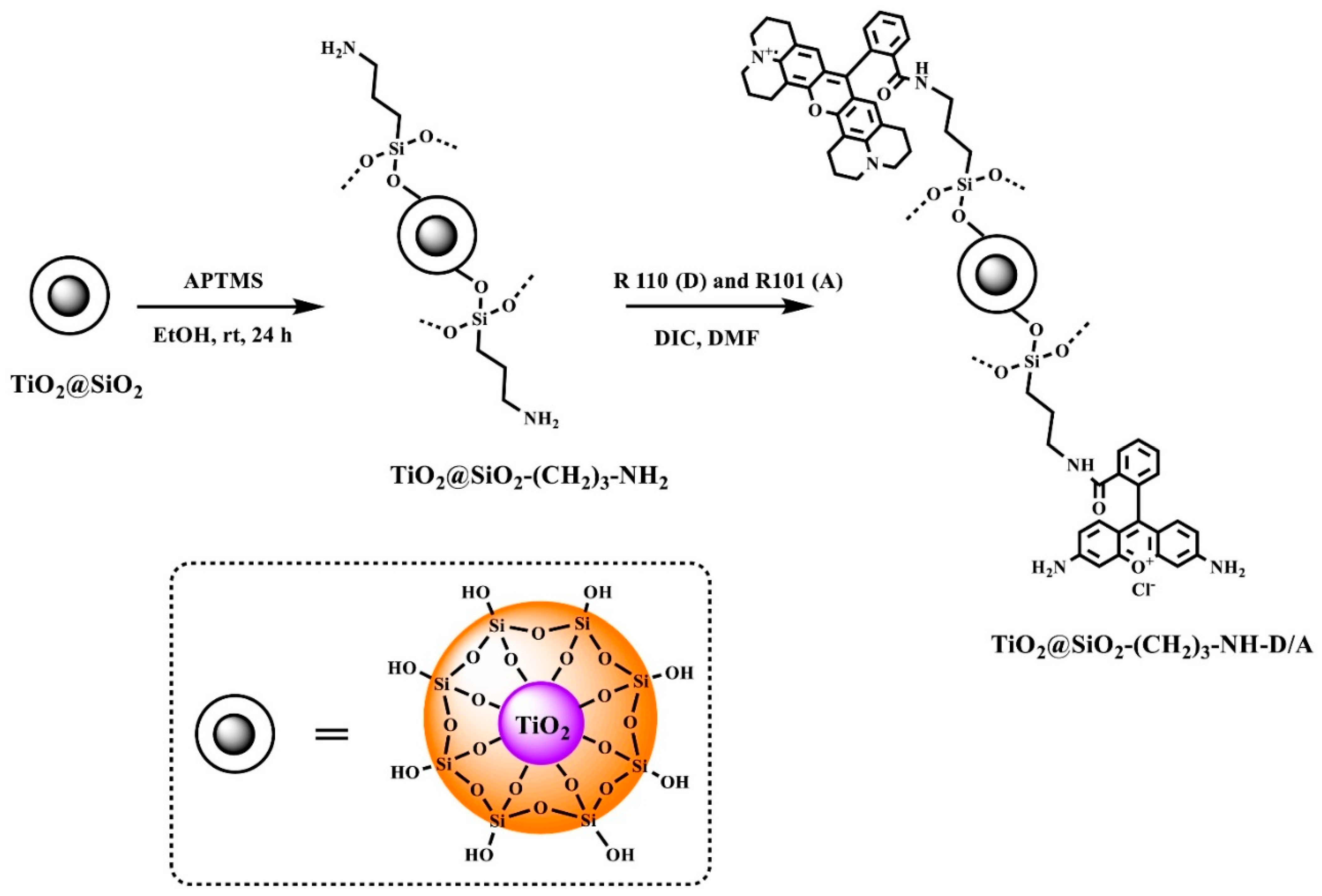


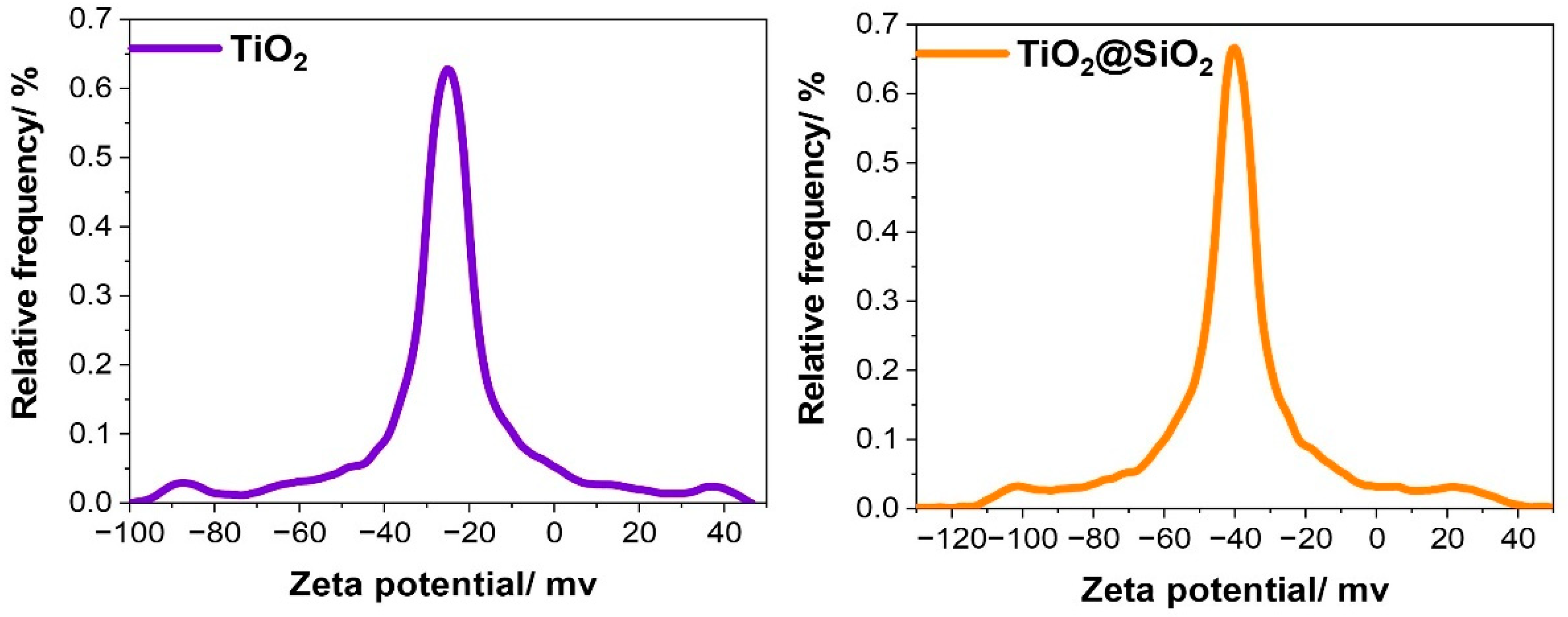
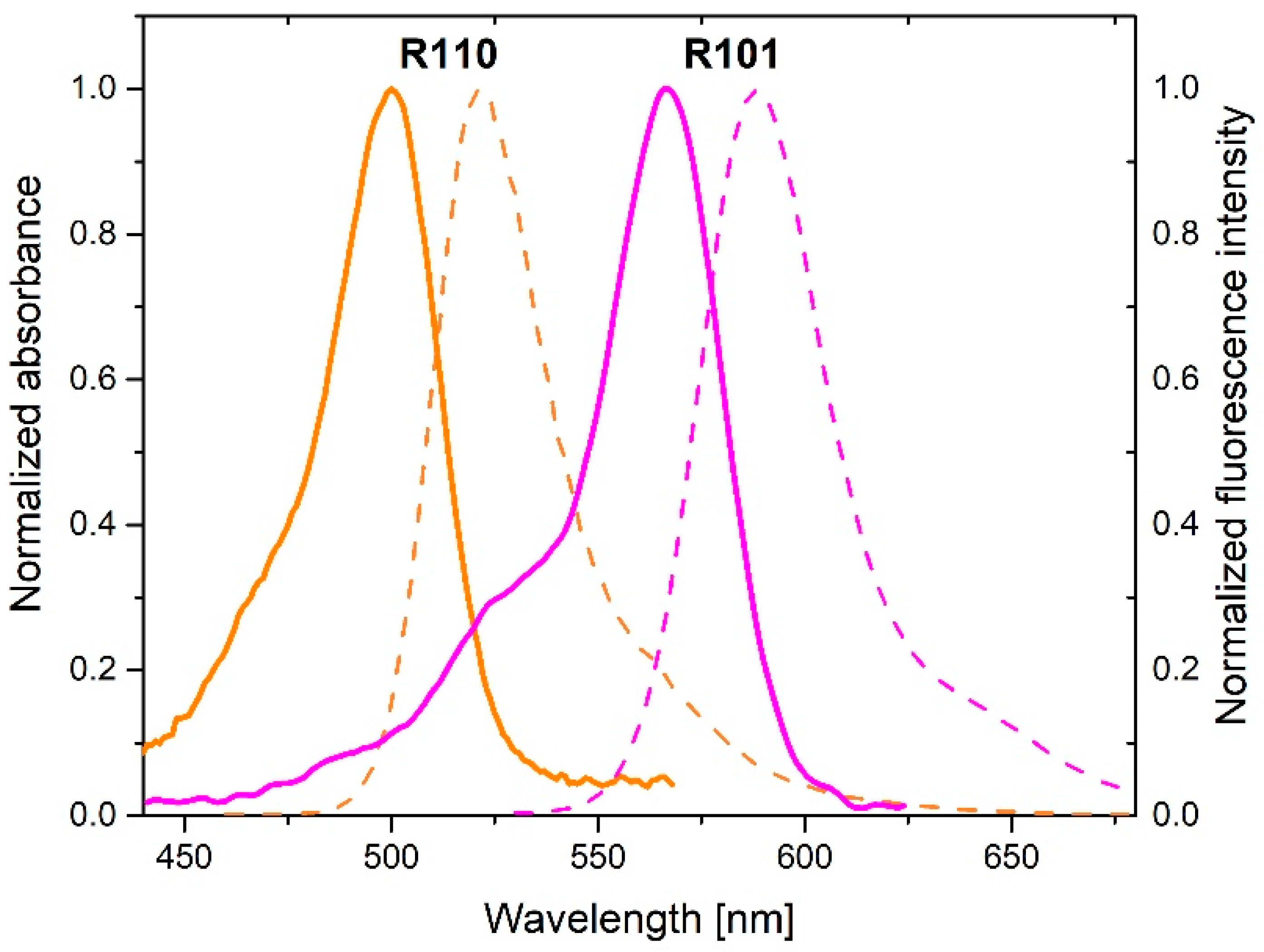
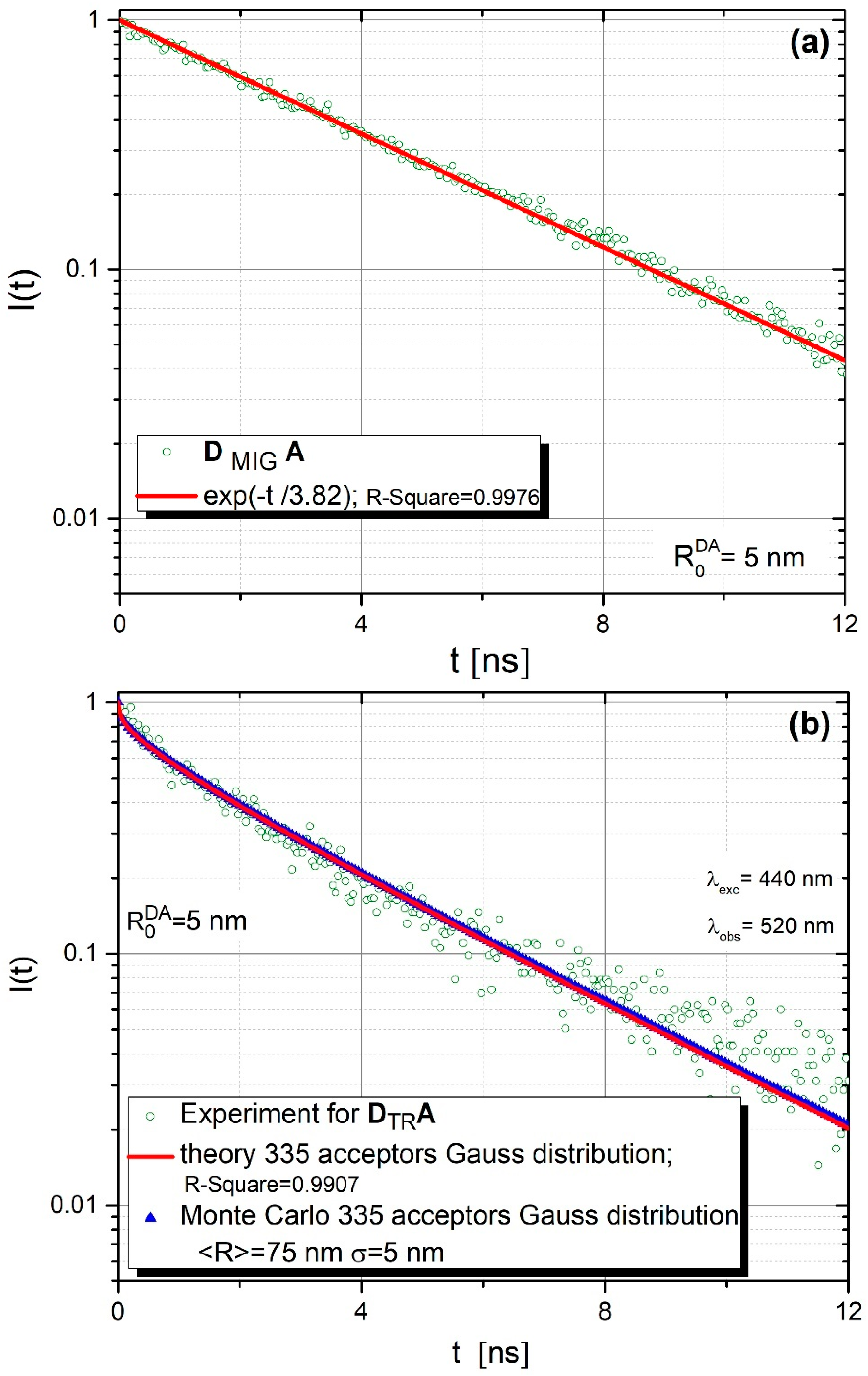



Publisher’s Note: MDPI stays neutral with regard to jurisdictional claims in published maps and institutional affiliations. |
© 2022 by the authors. Licensee MDPI, Basel, Switzerland. This article is an open access article distributed under the terms and conditions of the Creative Commons Attribution (CC BY) license (https://creativecommons.org/licenses/by/4.0/).
Share and Cite
Synak, A.; Adamska, E.; Kułak, L.; Grobelna, B.; Niedziałkowski, P.; Bojarski, P. New Core-Shell Nanostructures for FRET Studies: Synthesis, Characterization, and Quantitative Analysis. Int. J. Mol. Sci. 2022, 23, 3182. https://doi.org/10.3390/ijms23063182
Synak A, Adamska E, Kułak L, Grobelna B, Niedziałkowski P, Bojarski P. New Core-Shell Nanostructures for FRET Studies: Synthesis, Characterization, and Quantitative Analysis. International Journal of Molecular Sciences. 2022; 23(6):3182. https://doi.org/10.3390/ijms23063182
Chicago/Turabian StyleSynak, Anna, Elżbieta Adamska, Leszek Kułak, Beata Grobelna, Paweł Niedziałkowski, and Piotr Bojarski. 2022. "New Core-Shell Nanostructures for FRET Studies: Synthesis, Characterization, and Quantitative Analysis" International Journal of Molecular Sciences 23, no. 6: 3182. https://doi.org/10.3390/ijms23063182






